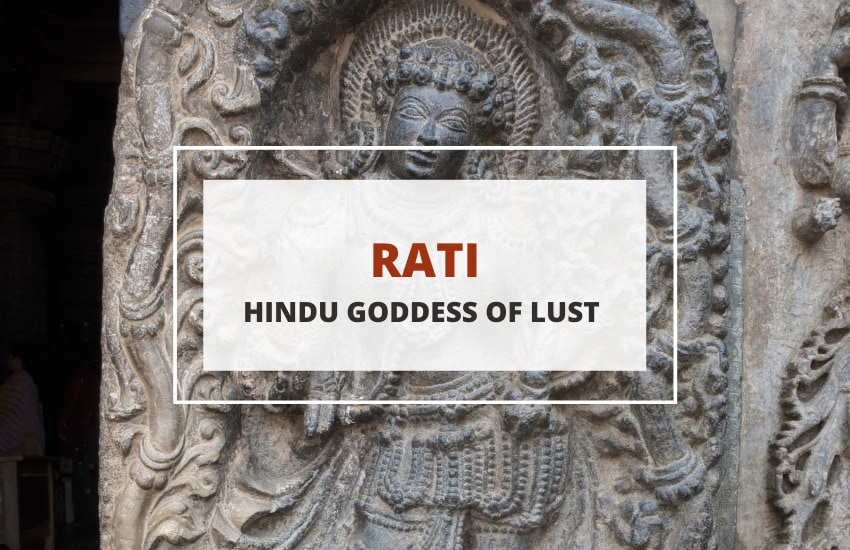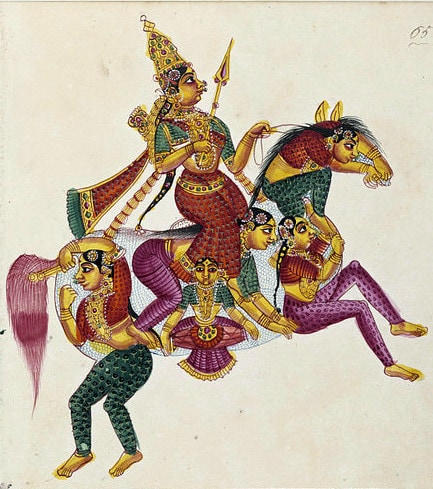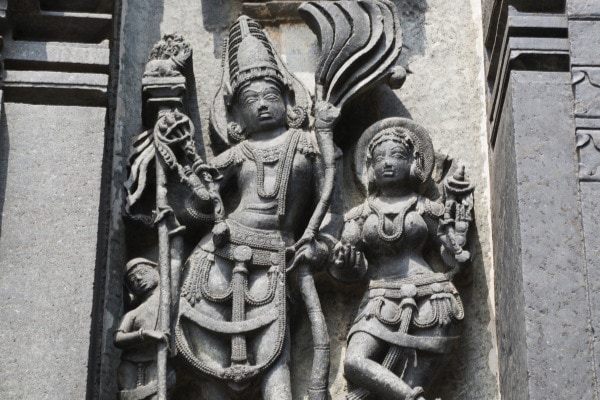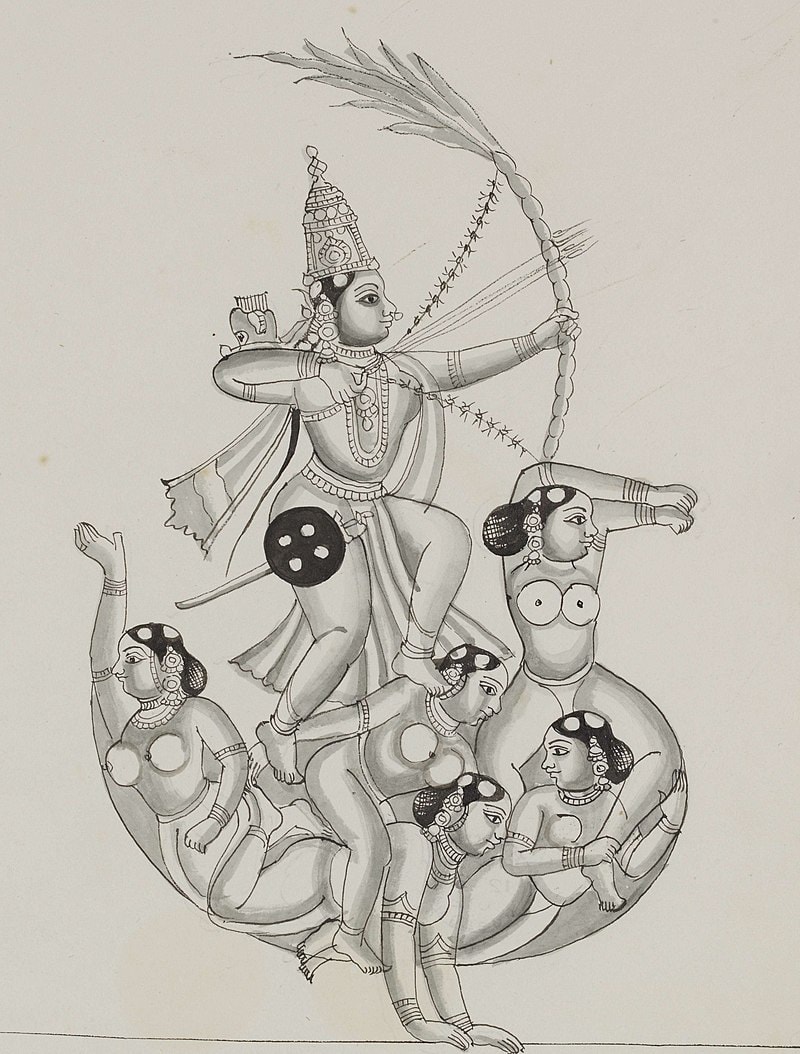
Gorgeous and sensual, with thin hips and luscious breasts, the Hindu goddess Rati is described as the most beautiful woman or deity to have ever lived. As a goddess of desire, lust, and passion, she is a faithful consort to the god of love Kamadeva and the two are often worshipped together.
But, as with any great woman, there is much more to Rati than meets the eye and her life’s story is even more fascinating than her physique.
Who is Rati?

In Sanskrit, Rati’s name literally means the pleasure of love, sexual passion or union, and amorous enjoyment. That is a major part of how she’s depicted as Rati was said to be able to seduce any man or god she wanted.
As with most deities in Hinduism, Rati also has many other names and each of them tells us another piece of her story or character. She is called Ragalata (wine of love), Kamakala (part of Kama),Revakami (wife of Kama), Pritikama (naturally seducing), Kamapriya (beloved of Kama), Ratipriti (naturally aroused), and Mayavati (mistress of illusion – more on that one below).

As several of her names imply, Rati is an almost-constant companion to the god of love Kamadeva. The two are often shown together, each riding on their own giant green parrot. Like Kamadeva, Rati too sometimes carries a curved saber on her hip, but neither of them likes to use such weapons. Instead, Kamadeva shoots people with his flowery arrows of love and Rati simply seduces them with her looks.
Myths Involving Rati
A Most Peculiar Birth
The bizarre circumstances around Rati’s birth are described in detail in the Kalika Purana text. Accordingly, the first being to be created was Kamadeva, Rati’s future lover and husband. After Kama sprang forth from the mind of the Creator god Brahma, he started shooting love into the world using his flowery arrows.
Kama himself needed a wife, however, so Brahma ordered Daksha, one of the Prajapati (primal gods, agents of creation, and cosmic forces), to find Kama a suitable wife.
Before Daksha could do that, however, Kamadeva used his arrows on Brahma and the Prajapati, both of whom immediately got uncontrollably and incestuously attracted to Brahma’s daughter Sandhya (meaning twilight or dawn/dusk). The god Shiva passed by and saw what was happening. He immediately began to laugh, which embarrassed both Brahma and the Prajapati so much that they began to tremble and sweat.
It was from the sweat of Daksha that Rati was born, so Hinduism views her as literally born from the sweat of passion caused by Kamadeva. Daksha then presented Rati to Kamadeva as his future wife and the god of love accepted. Eventually, the two had a couple of children – Harsha (Joy) and Yashas (Grace).
An alternative story from the Brahma Vaivarta Purana says that after the gods lusted after Brahma’s daughter Sandhya, she became so embarrassed herself that she committed suicide. Fortunately, the god Vishnu was there, and he resurrected Sandhya, named that reincarnation Rati, and married her to Kamadeva.
Suddenly Widowed
One of the key stories of both Kamadeva and Rati is that of the battle between the demon Tarakasura and a host of heavenly gods, including Indra. The demon was said to be immortal and impossible to defeat by anyone other than Shiva’s son. What’s worse is that Shiva was meditating at the time as he was grieving the loss of his first wife Sati.
So, Kamadeva was instructed by Indra to go and wake Shiva up as well as to make him fall in love with the fertility goddess Parvati so that the two could have a child together. Kamadeva did exactly as he was told by first creating an “untimely spring” and then shooting Shiva with his magic arrows. Unfortunately, while Shiva did fall for Parvati, he was still angered at Kamadeva for waking him up, so he opened his third eye and incinerated him.
Utterly devastated, Rati went mad in the Matsya Purana and the Padma Purana versions of the myth, and smeared her husband’s ashes over her body. According to the Bhagavata Purana, however, she immediately underwent penance and pleaded with Shiva to resurrect her husband. Shiva did so and raised him from the ashes but under the condition that Kamadeva would remain incorporeal and only Rati would be able to see him.
A Nanny and A Lover
Another alternative to this story can be found in the Skanda Purana. There, as Rati was pleading with Shiva to revive Kamadeva and was undergoing some severe austerities, the divine sage Narada asked her “whose she was”. This angered the grief-stricken goddess, and she insulted the sage.
In retaliation, Narada provoked the demon Sambara to kidnap Rati and make her his. Rati managed to trick Sambara, however, by telling him that if he touched her, he too would be reduced to ashes. Sambara bought the lie and Rati managed to avoid becoming his mistress. Instead, she became his kitchen maid and assumed the name Mayavati (Maya meaning “mistress of illusion”).
As all that was happening, Kamadeva was reborn as Pradyumna, the son of Krishna and Rukmini. There was a prophecy that Krishna’s son would one day destroy Sambara. So, when the demon heard of Krishna’s newborn son, he kidnapped him and threw him in the ocean.
There, Kama/Pradyumna was swallowed by a fish and that fish was later caught by some fishermen. They, in turn, brought the fish to Sambara’s home where his kitchen maid – Mayavati – started to clean and gut it. As she cut the fish open, however, she found the little baby inside, still alive. She had no idea that this child was Kamadeva reborn at the time and she simply decided to raise him as her own.
Soon after, the divine sage Narada informed her that Pradyumna was actually Kamadeva. While she still raised him, her motherly instincts eventually changed to a wife’s infatuation and passion. Rati/Mayavati tried to become Kama/Pradyumna’s lover again, but he was initially confused and hesitant as he only saw her as a mother figure. She explained to him that he was her husband reborn, and eventually he too started seeing her as a lover.
Now grown up, Pradyumna fulfilled the prophecy and slew the demon Sambara. After that, the two lovers returned to Krishna’s capital of Dwarka and married once again.
Symbols and Symbolism of Rati

As a goddess of love and lust, Rati is stunningly beautiful and irresistible to any man. Even though she is the quintessential seductress, she isn’t given any negative connotation in Hinduism, as she would be if she was a Western deity. Instead, she is viewed very positively.
Rati also doesn’t symbolize fertility as so many female deities of love do in other mythologies. Fertility is Parvati’s domain in Hinduism. Instead, Rati symbolizes just the carnal aspect of love –lust, passion, and the unsatiated desire. As such, she is the perfect partner of Kamadeva, the god of love.
In Conclusion
With glowing skin and stunning black hair, Rati is the personification of sexual lust and desire. She is divinely beautiful and can push anyone into overpowering carnal cravings. She is not malicious, however, nor does she bring people to sin.
Instead, Rati represents the good side of people’s sexuality, the ecstasy of being in your loved one’s embrace. This is also emphasized by Rati having two children with the love god Kamadeva, themselves called Harsha (Joy) and Yashas (Grace).








